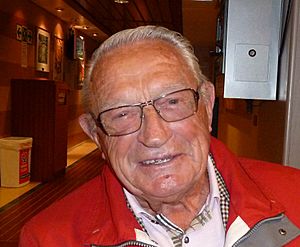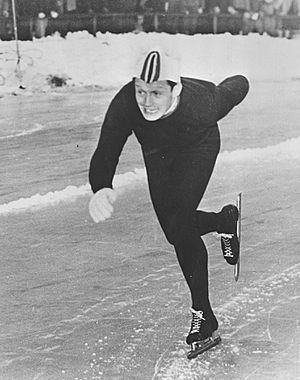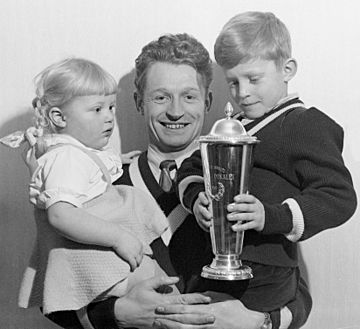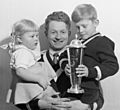Hjalmar Andersen facts for kids

Hjalmar Andersen onboard ferry Bastø II in October 2010
|
|||||||||||||||||||||||||||||||||||||||||||||||
| Personal information | |||||||||||||||||||||||||||||||||||||||||||||||
|---|---|---|---|---|---|---|---|---|---|---|---|---|---|---|---|---|---|---|---|---|---|---|---|---|---|---|---|---|---|---|---|---|---|---|---|---|---|---|---|---|---|---|---|---|---|---|---|
| Birth name | Hjalmar Johan Andersen | ||||||||||||||||||||||||||||||||||||||||||||||
| Nickname(s) | Hjallis | ||||||||||||||||||||||||||||||||||||||||||||||
| Born | 12 March 1923 Rødøy, Norway |
||||||||||||||||||||||||||||||||||||||||||||||
| Died | 27 March 2013 (aged 90) Oslo, Norway |
||||||||||||||||||||||||||||||||||||||||||||||
| Sport | |||||||||||||||||||||||||||||||||||||||||||||||
| Country | Norway | ||||||||||||||||||||||||||||||||||||||||||||||
| Sport | Speed skating | ||||||||||||||||||||||||||||||||||||||||||||||
| Club | Sportsklubben Falken | ||||||||||||||||||||||||||||||||||||||||||||||
| Achievements and titles | |||||||||||||||||||||||||||||||||||||||||||||||
| Personal best(s) | 500 m: 43.7 (1951) 1000 m: 1:30.6 (1954) 1500 m: 2:16.4 (1949) 3000 m: 4:49.6 (1954) 5000 m: 8:06.5 (1956) 10 000 m: 16:32.6 (1952) |
||||||||||||||||||||||||||||||||||||||||||||||
|
Medal record
|
|||||||||||||||||||||||||||||||||||||||||||||||
Hjalmar "Hjallis" Johan Andersen (born March 12, 1923 – died March 27, 2013) was a famous speed skater from Norway. He won three gold medals at the 1952 Winter Olympic Games held in Oslo, Norway. He was the only athlete to win three gold medals at those Olympics, making him the most successful athlete there.
People called him King Glad because he was always cheerful. He was one of Norway's most loved sportsmen ever. Four statues were made of him while he was still alive. He was even honored with a special funeral paid for by the state.
Contents
Growing Up and Starting Skating
Andersen was born on Rødøy, an island off the coast of Nordland in Norway. His mother was from there. His father, who was from Hammerfest, worked on boats as a boatswain (a senior sailor). When Hjalmar was a toddler, his family moved to Lademoen, a working-class area in Trondheim. In this neighborhood, sports and friendship were very important.
He started speed skating when he was 10 years old. He joined the sports club Falken. This club was part of the Workers' Sports Federation (AIF). His first competitions were small local events organized by the AIF. Other skaters from his club were Sverre Farstad and Henry Wahl. Later, Andersen, Farstad, and Wahl became known as "The Falken Trio."
When the German occupation of Norway began in 1940, Hjalmar was 17. All organized sports competitions stopped because people protested against the Nazi government. Like many others his age, he had to wait until 1946 to start his sports career again.
After finishing school around age 14, he worked as a delivery boy in a sports store. Later, he drove a lorry (truck) for several years. In 1950, when he was a top speed skater, he opened his own sports store in Trondheim. He ran this store until 1960.
His Amazing Skating Career
Hjalmar Andersen first competed internationally at the 1948 Winter Olympic Games in St. Moritz, Switzerland. He won a qualifying race for the 1500-meter event. However, he was not chosen for the Norwegian team for that distance. He was picked for the 10,000-meter team, but the ice was very bad, and he could not finish the race.
During the European Championship in Davos, he set a personal best time of 2:16.4 in the 1,500-meter race. He also set a new world record in the 10,000-meter race with a time of 16:57.4. He finished second overall in that championship.
Becoming a World Champion
Andersen was the best skater in the world from 1950 to 1952. In each of these three years, he became the World Allround Champion. This means he won the overall title for all distances. Only five male skaters have won this title three years in a row. In the same years (1950–1952), he also won the European Allround Champion title and the Norwegian Allround Champion title. This means he won the "triple crown" (World, European, and National championships) for three years in a row! He also set three world records during this time.
The Famous Flash Incident
A very memorable event in his career was the European Championship in 1951 at Bislett Stadium in Oslo. Speed skating was super popular in Norway back then. About 25,000 people cheered for the skaters during the two-day event. Even King Haakon VII was there!
During the competition, Andersen won the first three races. He was clearly going to be the overall champion before the 10,000-meter race. But after 11 laps, Andersen fell! He tried to keep going, but one of his skates was broken, so he had to leave the ice. People quickly thought that Andersen's fall was caused by a flash from a photographer named Johan Brun from the newspaper Dagbladet.
It was decided that Andersen could skate the 10,000 meters again. A group of judges would then decide if his second run should count. Meanwhile, Brun quickly went to his newspaper to develop his film. He came back with the photo he took when Andersen fell. The picture showed that Andersen's eyes were closed at that exact moment. The judges decided that the flash had blinded Andersen.
So, the result from his second 10,000-meter run became official. He won both the 10,000 meters and the overall championship! Brun and Andersen remained friends later in life. Brun later said that his electronic flash couldn't have blinded Andersen. He believed the judges made a mistake because they didn't know much about camera equipment.
Setting a New World Record
In a speed skating competition between Norway and the rest of the world in Hamar on February 10, 1952, Hjalmar Andersen set a new world record in the 10,000 meters. His time was 16:32.6. It was the first time a speed skater finished every lap in the 10,000 meters in less than 40 seconds. This was seen as an amazing world record! In Norway, this record became legendary and is often called the most famous sports record ever. The record lasted for eight years until Kjell Bäckman broke it.
Olympic Glory in Oslo
This record made people incredibly excited about Andersen for the 1952 Winter Olympics that started in Oslo just one week later. On February 17, Andersen won his first Olympic gold medal in the 5,000 meters, setting a new Olympic record. The next day, he won gold in the 1,500 meters. He finished the competition by setting another new Olympic record in the 10,000 meters on February 19. About 75,000 excited fans watched the three days of skating competitions!
Coming Back to the Ice
Andersen stopped skating after the 1952 Olympics. But he was convinced to try again in 1954. He became the Norwegian champion for the fourth time. That year, he also won both the 5,000-meter and 10,000-meter races at the European Championships in Davos, Switzerland. He won a silver medal in the overall standings. He also qualified for the 1956 Olympics and finished sixth in the 10,000-meter race.
During his career, he set four world records. His 10,000-meter world record in 1949 (16:57.4) was the first official world record under 17 minutes for that distance. Since he skated it outside Norway, it didn't count as a Norwegian national record. Andersen set eight Norwegian national records during his skating career. He represented the Sportsklubben Falken (Sports Club Falcon) in Trondheim.
Life After Skating
After he finished his skating career, Andersen moved to Tønsberg. Besides his skating success, Andersen was also a great cyclist at a national level. He received the Egebergs Ærespris award in 1951 for his achievements in both speed skating and cycling.
He began a long and happy career working for the "welfare service for merchant shipping." He helped sailors and worked there until he retired in 1990.
He was known as "Kong Glad" (which means "King Happy") and was famous for his sense of humor. He was a popular speaker. He also wrote several books, sharing memories from his sports career and telling funny stories.
He received the King's Medal of Merit in gold in 1998. He also won The Honor Prize at Idrettsgallaen with Knut Johannesen in 2013, just two months before he passed away.
His Family Life
Andersen married his girlfriend from when they were teenagers, Gerd. They were together until she passed away in 2004. They had three children.
Saying Goodbye to a Legend
On March 25, 2013, Andersen had a serious fall at his home in Tønsberg, Norway. He was taken to the hospital but never woke up. He died two days later on March 27, just two weeks after his 90th birthday. He is survived by his three children and his grandson, Fredrik van der Horst, who is also a speed skater and competed for Norway at the 2010 Winter Olympics in Vancouver, British Columbia.
The Norwegian government decided that Hjalmar Andersen should have a funeral paid for by the state. He was only the third athlete to receive this honor since 1998.
Prime Minister Jens Stoltenberg said that "Hjalmar Andersen became a sports legend when speed skating was a big part of Norway's identity. He also helped sailors when shipping was very important to the country. In this way, 'Hjallis' helped shape Norway after the war and won a huge place in the hearts of many generations of Norwegians."
King Harald V and Norway's Prime Minister Jens Stoltenberg attended the funeral ceremony at Tønsberg Cathedral on April 4, 2013. The Prime Minister also gave a speech.
All His Medals and Records
Here is a list of the medals Andersen won at important championships:
| Championships | Gold medal | Silver medal | Bronze medal |
|---|---|---|---|
| Winter Olympics | 1952 (1500 m) 1952 (5000 m) 1952 (10000 m) |
– | – |
| World Allround | 1950 1951 1952 |
– | – |
| European Allround | 1950 1951 1952 |
1949 1954 |
– |
| Norwegian Allround | 1950 1951 1952 1954 |
– | 1949 1956 |
During his career, Andersen set four world records:
| Discipline | Time | Date | Location |
|---|---|---|---|
| 10,000 m | 16.57,4 | 6 February 1949 | |
| 5000 m | 8.07,3 | 13 January 1951 | |
| 10,000 m | 16.51,4 | 27 January 1952 | |
| 10,000 m | 16.32,6 | 10 February 1952 |
Here are the Norwegian records Hjalmar set:
| Event | Result | Date | Venue |
|---|---|---|---|
| Big combination | 193.940 | 29 January 1950 | Trondheim |
| Big combination | 192.708 | 12 February 1950 | Oslo |
| 5000 m | 8:13.8 | 4 March 1950 | Gjøvik |
| 5000 m | 8:07.3 | 13 January 1951 | Trondheim |
| Big combination | 190.707 | 14 January 1951 | Trondheim |
| 10000 m | 17:00.1 | 20 January 1952 | Oslo |
| 10000 m | 16:51.4 | 27 January 1952 | Gjøvik |
| 10000 m | 16:32.6 | 10 February 1952 | Hamar |
In Hjalmar's time, a Norwegian record could only be set in Norway. So, his world record in Davos could not also be a Norwegian record.
Here are his personal best times:
| Event | Result | Date | Venue | WR |
|---|---|---|---|---|
| 500 m | 43.7 | 13 January 1951 | Trondheim-Stadion | 41.8 |
| 1000 m | 1:30.6 | 2 February 1954 | Davos | 1:28.4 |
| 1500 m | 2:16.4 | 6 February 1949 | Davos | 2:13.8 |
| 3000 m | 4:49.6 | 30 January 1954 | Davos | 4:40.2 |
| 5000 m | 8:06.5 | 29 January 1956 | Lagua Misurina | 7:45.6 |
| 10000 m | 16:32.6 | 10 February 1952 | Hamar-Stadion | 16:51.4 |
Awards
- Morgenbladets gold medal, 1949
- Egebergs Ærespris, 1951
- Fearnleys olympiske ærespris, 1952
- Norwegian Sportsperson of the Year, 1952
- Olavstatuetten (awarded by Adresseavisen), 1976
- King's Medal of Merit in gold, 1998
- The Honor Prize at Idrettsgallaen, 2013
Books
- Hjalmar Andersen: Harde løp (1951)
- Hjalmar Andersen: Siste runde (1952)
- Hjalmar Andersen and Sverre E. Mortensen: Hva idretten ga meg (1983)
- Hjalmar Andersen and Sverre E. Mortensen: Medaljens bakside (1985)
- Hjalmar Andersen: Den gode, gamle, gale istida (1989)
- Hjalmar Andersen and Knut-Anders Løken: Gull og glis (1990)
Images for kids
See also
 In Spanish: Hjalmar Andersen para niños
In Spanish: Hjalmar Andersen para niños






